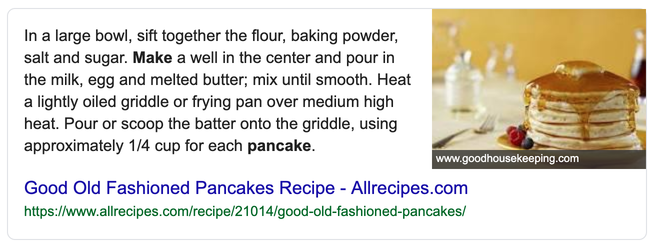Since the beginning of time, well since about 2001, major search engines have been working away at improving their algorithms to better understand and recognise the content available to us on the world wide web. This has, of course, brought us the joys of SERP (Search Engine Results Page) features, which include favourites like Adwords, shopping results (a personal favourite), and the often confused featured snippets and rich snippets.
What is the difference between rich and featured snippets?
Rich and featured snippets are both organic search results with a visual layer, which makes them so much more enticing and clickable. The biggest difference between rich and featured snippets is that they have a different layout and provide different types of information when they appear on your search results page (yes, we are judging them on looks).
Rich snippets are the top results that appear in your search which include star ratings and extra information. If you search ‘pancake recipe’ you will probably find the top results are linking to pancake recipes and include a star rating and extra info about the cooking time, etc. Other examples can include, products with a star rating and retail price, or a business with a star rating and address.

Whereas, featured snippets usually (not always) answer a question and will appear in a list, paragraph or table format. If you search ‘How do I make pancakes’, it will probably appear with the method of the top pancake recipe result, the link to the full recipe and the related image. Other examples of this might include a step-by-step method to a task in a list format or dates and times for an event in a table.

Featured snippets can have a much higher click rate than other search results, even more so than the paid ads which sit above them, so they are definitely worth striving for in the world of organic search.
(Please excuse the food reference and apologies if you now feel like pancakes.)
How can snippets be created for your website?
Snippets are created by adding Schema markup to a website. Think of this as marking up the content on your site using structured data to help the search engine’s back end figure out what specific information is on your page. This gets you ahead of the game, by not being reliant on search engines interpreting the content and information on your page, therefore allowing them to display the most relevant results (like your site). Who doesn’t love being a step ahead of the competition?
Adding Schema markup to your back end won’t send your site to the top of the results page straight away (that would be too easy). The benefit of this is that the relevant information will be recognised easier and hopefully result in more clicks, more traffic, and because it’s super relevant to the search, more time spent on your site.
Is there a way to get a featured or rich snippet?
There is no specific rule to making your way to snippet stardom, sorry! It generally comes down to good old fashioned excellent copywriting and the content that is available on your website. To ensure that you have the best chance of a coveted place on Google’s results page start by considering these points when writing content to be featured;
- What are the questions your target audience will be searching for?
- The keywords you are using in the questions and answers
- Research - Take a look at the feature and rich snippet results in your industry to use as a guide when writing content, for example, word count, information included, etc.
To recap, in a nutshell. Rich snippets are a fancy-pants, better-than-your-average organic search result which includes extra info and a star rating for the product or business. Featured snippets are a super-chic, attention-grabbing organic search result with a layout that can include a table, paragraph or list. Both options are a great way to reach your target audience!
If you’re ready to find out how snippets can work for you, get in touch with our expert Klypsters via phone, email or live chat now!



